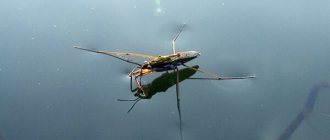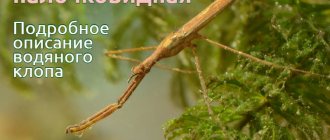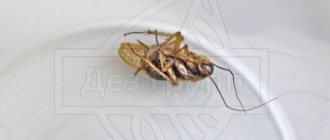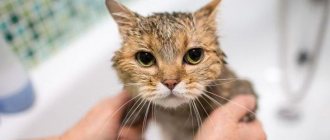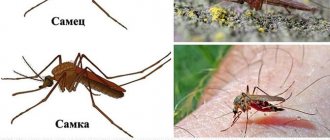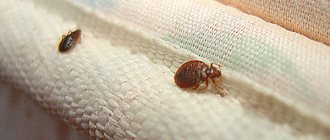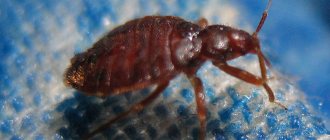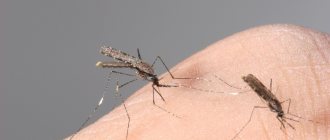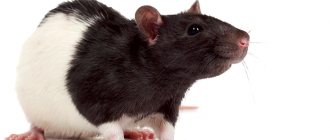02/28/2018 Category: Bedbugs Author: Irina Vasilyeva
If you have ever been on the banks of rivers with a slow flow, stagnant ponds or lakes, you have probably seen amazing insects on exorbitantly long, thin legs. They easily glide through the water, as if on an elastic film, deftly managing three pairs of legs. These are water striders, aquatic relatives of the large family of bugs.
- 2 Life expectancy, stages of development
- 3 What do water striders eat?
3.1 Video: how a water strider hunts
- 5.1 Video: why water striders don’t drown
How long does Water Strider live?
Reproduction: incomplete metamorphosis. Food: insects. Life expectancy: 2 years.
Interesting materials:
What is the month of June in the year? What historical event happened in 1242? What decision did Kutuzov make in 1812 in the village of Fili? What event happened on February 23, 1917? What event happened on April 12, 1961? What event happened on April 5, 1242? What event happened on May 5, 1789? What event happened on November 7, 1917? What event happened in 1943? What event happened in 490 BC?
Physics in the animal world: how water striders run on water
Among Habr's readers, there are probably no people who have never seen a water strider.
This is a very common family of insects, which includes about 1,700 species. Most are freshwater, but there are also species that live on the coasts of seas and oceans. Water striders spend their entire lives on the surface of the water. They move along it as easily as ordinary insects move on land. Water striders, at least most species, are predators. They feed on small organisms, but are not afraid to attack larger prey. Sometimes an unsuspecting fry swims to the surface of a reservoir, and immediately a “harpoon” is inserted into it - the proboscis of a water strider, which injects gastric juice into the victim’s body and begins to absorb nutrients. In general, a good plot for a non-boring film. But the most interesting thing about the water strider is its ability to run on water. How did this insect get its superpower?
Physics and chemistry are friends of water striders
In most cases, water striders float due to, firstly, the presence of a layer of water-repellent fats on the body and limbs, and secondly, thanks to special hairs on the tips of the legs.
Thus, there are a lot of these hairs on the hind legs of insects, their number exceeds 16,000 per mm2. The water striders rest on them, and they also serve as a steering mechanism. There are also a lot of hairs on the middle and forelimbs, but not so much. Water striders have to tidy up their hair quite often, because if this is not done, the water will wet the water strider’s body and it will drown.
The purpose of the hairs is to create a cushion of air on which the water strider rests. If you look closely on a sunny day, you can see how the water sparkles around the water strider’s legs - this is just an airy “cocoon” or, if you like, an air cushion. At the bottom of a shallow reservoir, the shadow of a water strider is visible - and the shadow is always thick around the legs, although the legs themselves are quite ordinary - this is a shadow from the air cushion created by the hairs of the limbs.
By the way, Chinese scientists have discovered an interesting fact - from time to time the shadow of the leg ceases to be clear, and then the water strider presses it to the front of the body, where the glands that secrete a non-wettable substance are located. After this procedure, the shadow of the limb becomes clear again.
The hairs of water striders are also unusual; there is a groove running along each of them, which prevents the penetration of water - it cannot seep into such a small volume. The angle of contact of water with the surface of the water strider's limbs is about 168 degrees, which prevents the legs from getting wet.
Some types of water striders also move using a “chemical engine”. At the back of the insects' body there is a specialized gland that secretes a fat-like substance. It changes the force of surface tension, reducing it. As a result, the water strider moves forward thanks to the laws of physics. The water strider glides in the water “hole” it creates. When you need to go ashore, the release of the hydrophobic substance is reduced, and the water strider is pulled out using capillary forces.
Water strider travel mode
These insects got their Russian name due to the fact that when moving, they seem to “measure” the distance traveled through the water. But, as it turned out, this is only one mode of movement of the water strider - this is what it does when it is not frightened and does not pursue the victim, but simply moves along the surface of the water.
Most species alternately lean on three limbs, moving the other three forward, and repeating this cycle.
In moments of danger or pursuit of prey, the water strider sticks the tips of its middle paws, which do not have many hairs, into the surface of the water, steers with its hind legs, and scoops up the water with its front ones. The only thing is that the front legs do not plunge into the water, but push off from the surface of the water.
And lastly, water striders can jump on the water. Not very far, but it's still a jump. They jump in case of danger - you can observe this if you try to cover the water strider with your palm on the water. To escape, she will not only “row”, but also jump, and quite actively.
By the way, if you change the surface tension of water - for example, using surfactants (surfactants), then the water striders will drown. That is why they are not present in places where industrial waste is discharged into water - the latter change the properties of water and water striders (and not only them) cannot live in such places.
Water striders benefit science
A group of Chinese scientists has developed an ultra-precise method for measuring Archimedes' force.
The idea first came to the mind of a Chinese physicist named Yu Tian from Tsinghua University in Beijing. The scientist went to the shore of a pond in one of the parks of the Chinese capital on a sunny day. There he looked at the water and noticed water striders that cast a shadow. As mentioned above, the shadow from their paws was different from the configuration of the tips of the limbs.
The scientist realized that this was caused by the curvature of the water under the influence of the weight of the water strider, no matter how small it was. And then he realized that with the help of shadows cast by objects on the surface of the water, it was possible to measure the Archimedes force, and these measurements were extremely accurate. The sensitivity limit of the method is 1 piconewton.
“The geometry of the shadow that an object casts on the water allows us to very accurately calculate the curvature of the water surface underneath it, and, accordingly, determine the volume of this “hole” and calculate the buoyancy force using Archimedes’ law. All this can be measured using a flashlight, a transparent vessel, water and a simple camera,” the scientist said.
Also robots
The results of the Chinese scientist's observations helped his team develop the concept of a robotic water strider.
At the moment, several such devices have been created, and one of them can even jump on the surface of the water, like a real water strider. The first creators of the robotic water strider were the team from the School of Chemical Engineering and Technology. The developers used both the results of observations of colleagues and their own research.
Then another robot was created, whose weight was much more than that of the water strider - 11 grams instead of fractions of a gram. It is able to move through water and does it quite quickly - up to 5 km/h, which is comparable to the walking speed of an adult.
Well, another illustrative example is a robotic water strider, created by a joint team of researchers from South Korea and the USA. This robot very much resembles a water strider; its size is about 7 cm including its “legs”.
It not only moves on the surface of the water, but also jumps, and quite high.
The scope of application of robotic water striders is search and rescue operations, studying the physical and chemical properties of water, monitoring pollution, etc.
A little physics
Before revealing the secret of water striders, it is necessary to remember some basics of the physical properties of water. As is known, the air and water environments are separated from each other by a special film of surface tension. At the boundary of two phases, the attractive forces arising between water molecules are not balanced, i.e. the sum of forces acting downwards turns out to be many times greater than the sum of forces acting upwards. Due to this, the density of water on the surface of the reservoir is slightly higher than in the main water layer.
But that is not all! Molecules tending downward lead to the appearance of a kind of elastic membrane that is capable of supporting objects with a density higher than this on the surface of the water. However, there is one condition: these objects must be dry. If you wet them, they will independently attract water molecules to themselves, which will disrupt the structure of the surface film.
It is curious that various living organisms use these amazing physical properties of the water film for their own purposes. It is worth moving from physics to zoology. As you know, life on the border of two habitats has a very noticeable advantage. The most famous inhabitants of the surfaces of reservoirs are, of course, water striders.
Set for drip irrigation KPK 24 and KPK 24K
The Samara enterprise PKF Istok LLC produces drip irrigation kits KPK 24 with drip tapes. The configuration of the KPK 24K differs in that it has a controller, that is, the water supply is automated. The system is designed to supply water from a tank, maximum pressure 1.2 atm, so it cannot be connected to the water supply network without a pressure reducer.
- drip tape 24 meters long, the recommended length of one irrigation line is no more than 6 meters;
- tape wall thickness 0.2 mm,
- distance between droppers 30 cm,
- water consumption 1.7 l/hour,
- working pressure 0.3-1.2 atm.
The kit includes a filter for fine water purification; if there is a lot of contaminants, install a gravel filter first. The method of assembling a drip irrigation system is standard: a supply pipeline from a hose with an internal diameter of 15 mm is mounted from the tap at the bottom of the container (not included in the kit). Having reached the beds, cut the hose, insert a tee (included in the kit), and connect a ribbon of the required length to the free outlet. On the other side of the tee, a piece of pipe of the same diameter is installed. Its length is up to the next tape. This is how you assemble the entire circuit; in the last watering line, not a tee is used, but an angle (included in the kit).
Drip irrigation set KPK 24
The controller in the KPK 24K set provides ample opportunities for programming irrigation. The duration of water supply is from 1 minute to 9 hours 59 minutes. There are sixteen programs that set the frequency of watering - from one to 16 times a day, and the start time for each watering is set with an accuracy of up to a minute. You can also choose which days of the week to turn on the water. So the KPK 24K drip irrigation system is truly automatic.
There are restrictions on the minimum pressure: the controller will work if the pressure in the system is more than 0.1 atm (maximum 4 atm). When supplying water from a barrel, it should be installed 1 meter below the outlet from the tank. Then there will be no problems with water supply. Also: for the main water supply, a hose with an internal cross-section of 13 mm must be used. Power is provided by two 1.5 Volt batteries or alkaline batteries of the same capacity.
Offspring
Aquatic arthropods reproduce by eggs. But their method of laying differs markedly. The female smoothie chooses the thickness of plant stems to lay eggs.
Paddlefish catch eggs with their offspring under deep algae or on other objects located under water.
Belostoma keeps future offspring under supervision all the time. The female lays eggs on the back of the male. There are usually so many eggs that its entire surface is filled.
A water bug with eggs on its back makes all movements (walks or swims). Before the appearance of the larvae, the future father is completely focused on caring for the offspring.
The male selects the required temperature regime for the eggs and offspring. Protects them from other predators, and also ensures that there is always good air circulation around the masonry.
During their life cycle, water bugs go through 3 main stages: egg, larva, and adult. The hatched larvae visually closely resemble adult individuals, but are significantly smaller in size.
Before the larvae transform into a full-fledged individual, several molts occur.
Portrait in a water interior
The appearance of aquatic insects is very different from their land relatives. The body of the water strider is long, elongated, resembles a boat or a stick, ranging in size from 1 to 3 centimeters.
The color is dim, from light gray or greenish to dark brown. The lower part of the back usually has a speckled pattern. Most species have membranous wings hidden under hard elytra.
The back of the water strider has a protective coloring, which helps it not to stand out against the background of the bottom.
Three pairs of legs are different in length, the middle and back are one and a half to two times larger than the size of the body. The front legs are the shortest and are used to regulate the speed of movement, as well as to capture and hold prey.
The middle and rear ones resemble oars or skis; they hold the bug on the water, are used for sliding and turning, and sometimes for jumping. All paws are equipped with small hairs-villi.
The head is small, with large round eyes and antennae that detect vibrations in air and water. The insect uses them for touch and smell.
The water strider's small head has a proboscis and large round eyes.
The oral apparatus is a sharp, jointed proboscis. With its help, the water strider pierces the victim's body and sucks out nutrients.
When the water strider is not hunting, it tucks its proboscis close to its body.
About 700 species of these insects are now known. Common for Russian reservoirs is Prudovaya (Gerris lacustris). There are also Big (Gerris rufoscutellatus), Armored (Gerris thoracicus), Velia (Velia currens), Stick (Hydrometra gracilenta). The largest species found on our territory is Bolshaya, reaches 1.7 cm in length, the most cold-resistant - Velia lives in the northern regions and can settle in cold springs. The rod has a narrow, elongated body, is common in Siberia, and moves its legs alternately when moving. This is the slowest water strider.
Life expectancy, stages of development
Mating occurs right on the water, in the warm season. A week after fertilization, females lay eggs on the stems or leaves of aquatic vegetation. The clutch of large species consists of a long ribbon of eggs glued together with mucus. Small ones lay single eggs, not treated with mucus.
Mating occurs on the water
Laying is carried out under the vigilant protection of the male. He jealously controls the surrounding space, scaring off potential enemies by hitting the water with his paws.
At one time, the female lays 40 to 50 eggs. They are whitish, cylindrical in shape, up to 1 mm in size. A week later, yellowish larvae (nymphs) emerge from the eggs, which gradually darken. The nymph resembles an adult (imago), but is more rounded.
The water strider larva is similar to the adult, but more rounded and smaller in size.
The larvae develop within a month, feeding on small insects. During this time, they go through 5 stages of development and end with molting. The folded abdomen, filled with food, straightens out.
The next breeding cycle occurs in mid-summer. At this time, insects of different ages are found in the reservoir.
Insects overwinter on the shore, finding a secluded place under stumps or in moss. Before this, they shed their wings, which no longer grow back after wintering. The full life cycle of water striders lasts a year.
General information about the species
It should be noted that this is a very common insect. The water strider lives almost everywhere, with the possible exception of the cold lands of the Arctic and Antarctic. Scientists classify these creatures as members of the family of hemiptera, a suborder of bedbugs. Today, more than 700 species of water striders are known, which differ not only in appearance and size, but also in their habitual way of life.
Danger and benefit for humans
Water bugs in our latitudes do not pose a danger to humans; it is not part of their diet. You can swim in reservoirs inhabited by water striders without fear.
In rare cases, water strider bites are possible, but they are practically painless and have no unpleasant consequences. The only danger is that microorganisms living in the reservoir can penetrate into the wound through the bite. Therefore, the bite site should be treated with a disinfectant composition: brilliant green, chlorhexidine, hydrogen peroxide.
The harm that bedbugs can cause to humans is by eating fry and eggs of valuable fish species. But if the population is small, the damage from such a feast is insignificant.
Read more about the consequences of a waterbug bite in our article - Waterbug bite: how to live after it.
Tropical varieties can cause more serious problems. In addition to the proboscis, they also have a more formidable weapon - a stinger. Their bite is painful, comparable to a wasp sting, and the affected area goes numb. The pain may persist for an hour, after which it passes. There is a danger of an allergic reaction to the secretion, in which case it is necessary to take an antihistamine.
The insects themselves can be beneficial; they regulate the number of horseflies by feeding on eggs laid in the water and attacking adult individuals. Eating dead insects and small animals, they act as orderlies, freeing the reservoir from carrion.
Water strider bugs are a necessary link in the ecological chain, so there is no point in fighting them. They perform an important role as cleaners of water bodies, without causing harm to humans and animals.
Natural enemies
The main enemies of water striders are birds and amphibians. The former catch insects in calm sunny weather, while the latter skillfully track them at the edge of the shore. Naturally, they cannot cause much harm to the population, but individual individuals will clearly have to come to terms with a sad fate.
But this bug has another enemy - the water mite. This parasite often attacks the back of the insect, leading it to complete exhaustion. Often such a symbiosis leads to the death of the water strider. And besides, it becomes a dangerous source of infection, capable of transmitting the parasite to other individuals of its species.
Notes
- [files.school-collection.edu.ru/dlrstore/50d0c166-f35a-4e14-8bf5-8545a19987ae/geris.htm Prudovaya Water Strider - Gerris Lacustris]
- [books.google.ru/books?id=PelhAAAAQBAJ&pg=PT84&lpg=PT84&dq=Gerris+lacustris+%D0%B2%D0%BE%D0%B4%D0%BE%D0%BC%D0%B5%D1%80%D0 %BA%D0%B0&source=bl&ots=XGNfQ6_Q7g&sig=F7Onkr0hBDXvNyYH7aWiuWXjTVs&hl=ru&sa=X&ei=jNTYU5qVEMWD4gS97IGYDQ&ved=0CFAQ6AEwCw#v=onepage&q=Gerris%20lacustris%20%D0%B2%D 0%BE%D0%B4%D0%BE%D0%BC %D0%B5%D1%80%D0%BA%D0%B0&f=false Life and customs of arthropods - Vladimir Polzikov - Google Books ]
- [animaldiversity.ummz.umich.edu/accounts/Gerris_lacustris/classification/ ADW: Gerris lacustris: CLASSIFICATION]
- ↑ 12
[www.itis.gov/servlet/SingleRpt/SingleRpt?search_topic=TSN&search_value=103846 ITIS Standard Report Page: Gerris lacustris] - [dic.academic.ru/dic.nsf/dic_biology/948/ Water striders]
- [www.naturespot.org.uk/species/water-measurer Water Measurer - Hydrometra stagnorum | NatureSpot]
- ↑ 12
[www.rspb.org.uk/wildlife/wildlifegarden/atoz/p/pondskater.aspx The RSPB: A to Z of a Wildlife Garden: Pond skater]
Gastronomic value
In Thailand, belostomy is a real delicacy; they are served fried or dried. The taste is like a cross between chicken and shrimp. An extract from the insect's anal glands is used as a flavoring additive for some types of soy sauce.
The water bug family includes six species, all of which are different from each other. They have a body size from 2 mm to 12 cm.
They lead an exclusively aquatic lifestyle, and all are predators. The most famous water bugs are the water strider and the smoothie.
Water strider bug
There are about 700 species of water strider bugs,
which differ from each other in color and size.
This insect has a long, elongated body, which can be from 1 mm to 3 cm. Three pairs of legs extend from it. The front ones are short, necessary for capturing prey and regulating the speed of movement. The middle and hind legs are used for locomotion and are 1.5-2 times longer
than the water strider's body.
Why do water strider bugs not drown, but run on the surface of the water?
Insects are held on the surface of the water due to the force of its tension. On the head of the bug there are special antennae that can catch even the faintest vibrations in the water surface. The mouthparts are piercing-sucking, and are used to suck out the contents of the victim.
